Legal Principles: Contract and Negligence Law Analysis and Cases
VerifiedAdded on 2020/02/05
|12
|4164
|55
Report
AI Summary
This report delves into the intricacies of contract and negligence law, providing a comprehensive analysis of legal principles and case studies. It begins with an introduction to contract and negligence legislation, emphasizing its role in promoting fairness in commercial transactions. The report then dissects the essential elements of a contract, including offer, acceptance, consideration, and intention, using case precedents to illustrate these concepts. It explores different types of contracts used by individuals and businesses in the UK, and examines the different terms incorporated into contractual deeds, such as express and implied terms. The report includes case scenarios, analyzing breach of contract, legality of exemption clauses, and the differences between contract and tort liability. The development of the "duty of care" concept in the tort of negligence is also discussed. The report concludes with a short letter advising on the recovery of losses in a given scenario and provides a detailed overview of the legal principles involved.
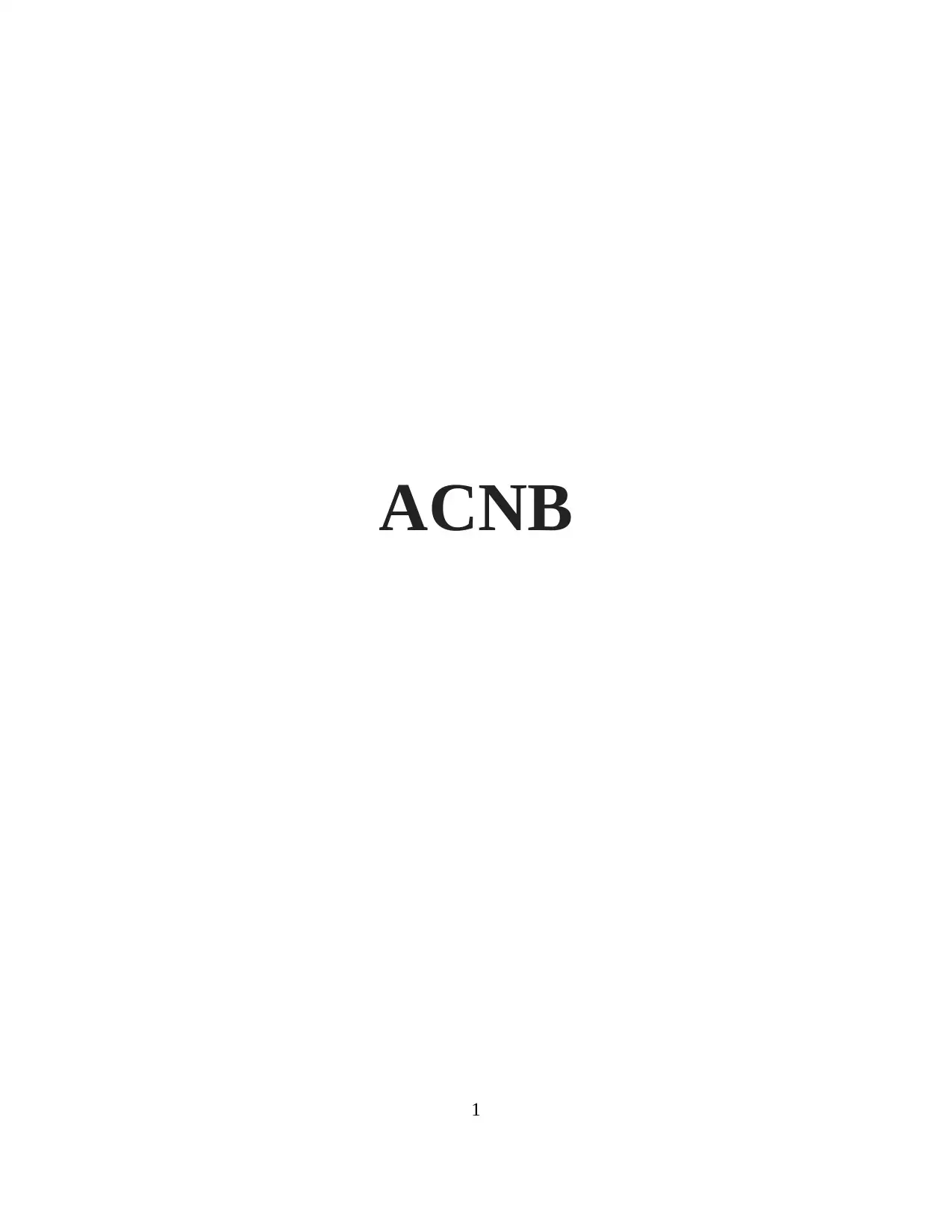
ACNB
1
1
Paraphrase This Document
Need a fresh take? Get an instant paraphrase of this document with our AI Paraphraser
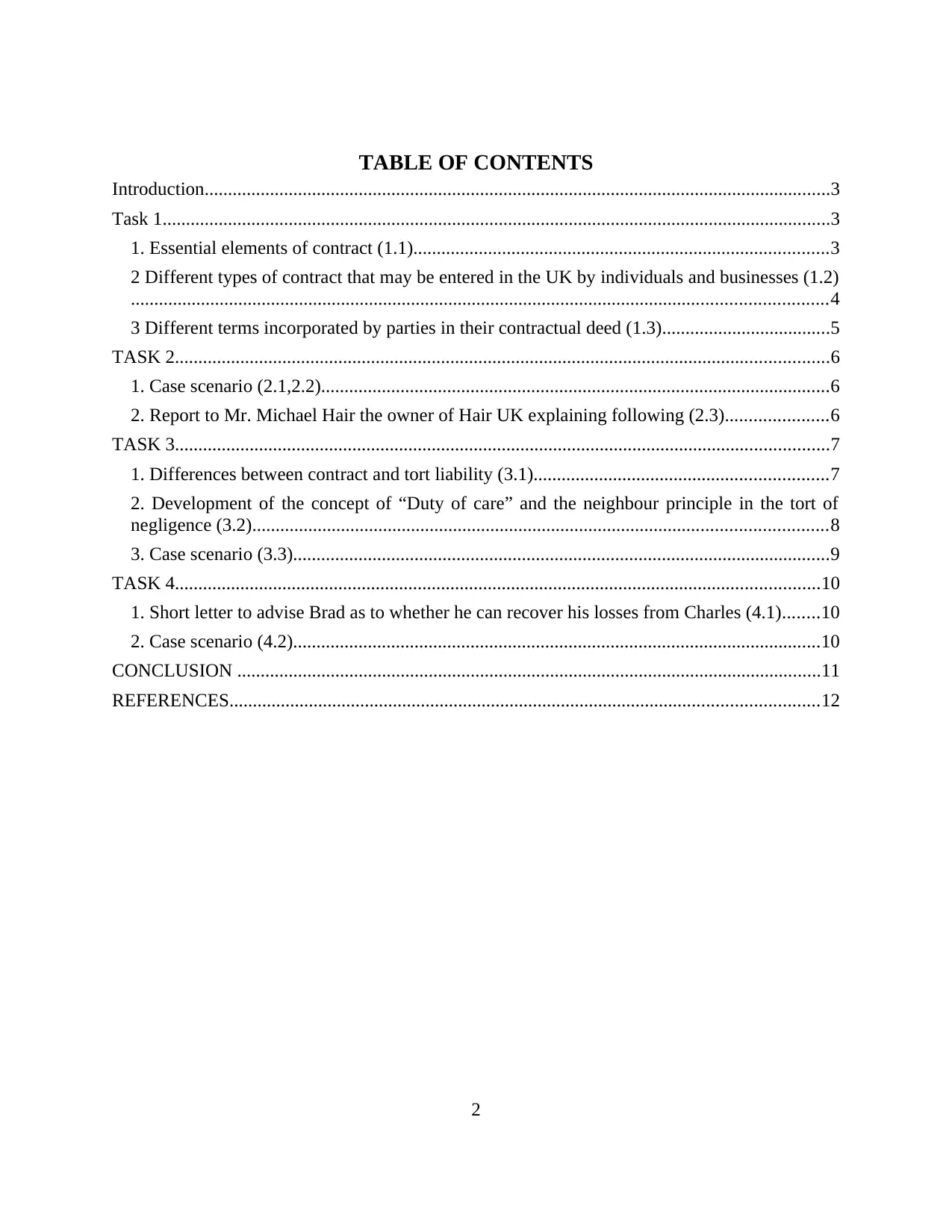
TABLE OF CONTENTS
Introduction......................................................................................................................................3
Task 1...............................................................................................................................................3
1. Essential elements of contract (1.1).........................................................................................3
2 Different types of contract that may be entered in the UK by individuals and businesses (1.2)
.....................................................................................................................................................4
3 Different terms incorporated by parties in their contractual deed (1.3)....................................5
TASK 2............................................................................................................................................6
1. Case scenario (2.1,2.2).............................................................................................................6
2. Report to Mr. Michael Hair the owner of Hair UK explaining following (2.3)......................6
TASK 3............................................................................................................................................7
1. Differences between contract and tort liability (3.1)...............................................................7
2. Development of the concept of “Duty of care” and the neighbour principle in the tort of
negligence (3.2)...........................................................................................................................8
3. Case scenario (3.3)...................................................................................................................9
TASK 4..........................................................................................................................................10
1. Short letter to advise Brad as to whether he can recover his losses from Charles (4.1)........10
2. Case scenario (4.2).................................................................................................................10
CONCLUSION .............................................................................................................................11
REFERENCES..............................................................................................................................12
2
Introduction......................................................................................................................................3
Task 1...............................................................................................................................................3
1. Essential elements of contract (1.1).........................................................................................3
2 Different types of contract that may be entered in the UK by individuals and businesses (1.2)
.....................................................................................................................................................4
3 Different terms incorporated by parties in their contractual deed (1.3)....................................5
TASK 2............................................................................................................................................6
1. Case scenario (2.1,2.2).............................................................................................................6
2. Report to Mr. Michael Hair the owner of Hair UK explaining following (2.3)......................6
TASK 3............................................................................................................................................7
1. Differences between contract and tort liability (3.1)...............................................................7
2. Development of the concept of “Duty of care” and the neighbour principle in the tort of
negligence (3.2)...........................................................................................................................8
3. Case scenario (3.3)...................................................................................................................9
TASK 4..........................................................................................................................................10
1. Short letter to advise Brad as to whether he can recover his losses from Charles (4.1)........10
2. Case scenario (4.2).................................................................................................................10
CONCLUSION .............................................................................................................................11
REFERENCES..............................................................................................................................12
2
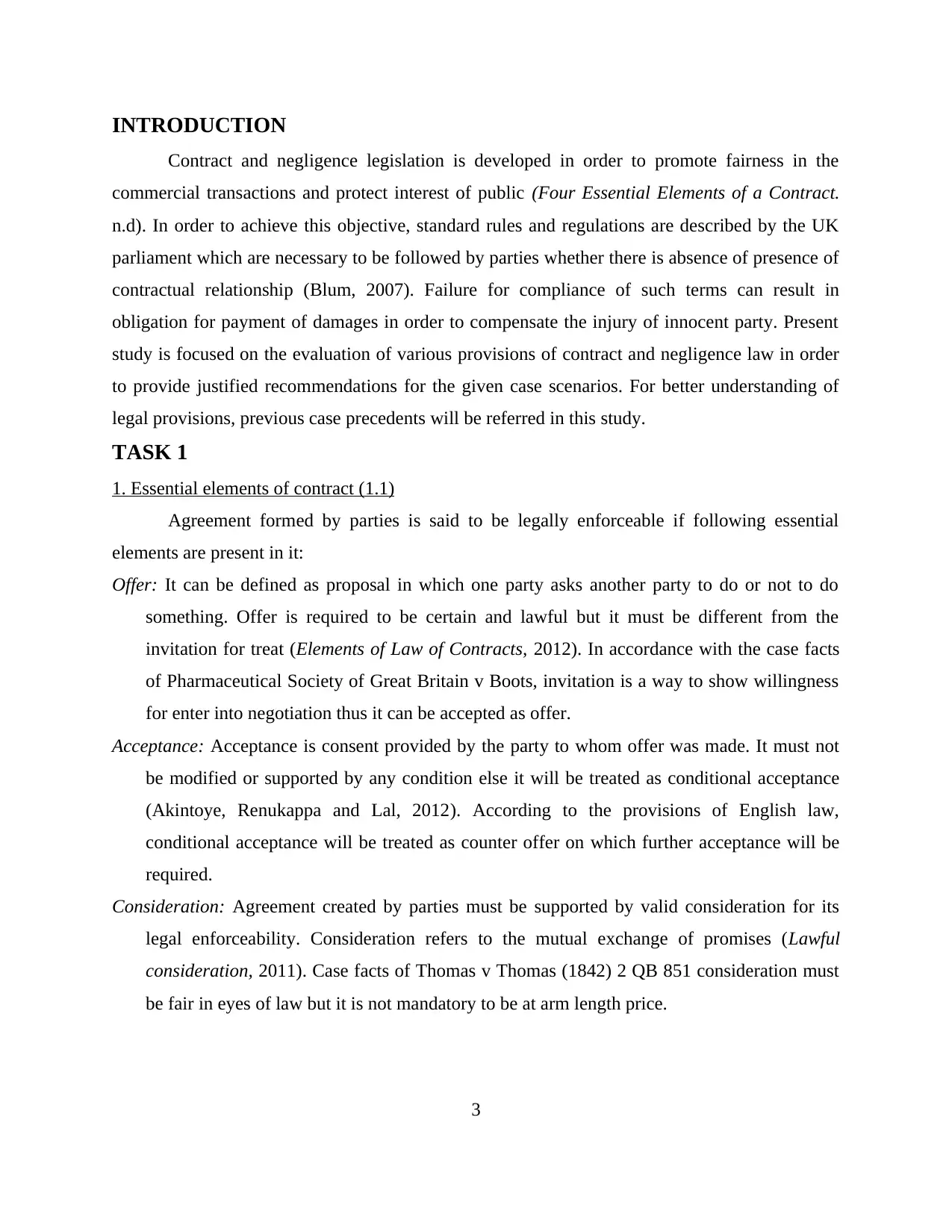
INTRODUCTION
Contract and negligence legislation is developed in order to promote fairness in the
commercial transactions and protect interest of public (Four Essential Elements of a Contract.
n.d). In order to achieve this objective, standard rules and regulations are described by the UK
parliament which are necessary to be followed by parties whether there is absence of presence of
contractual relationship (Blum, 2007). Failure for compliance of such terms can result in
obligation for payment of damages in order to compensate the injury of innocent party. Present
study is focused on the evaluation of various provisions of contract and negligence law in order
to provide justified recommendations for the given case scenarios. For better understanding of
legal provisions, previous case precedents will be referred in this study.
TASK 1
1. Essential elements of contract (1.1)
Agreement formed by parties is said to be legally enforceable if following essential
elements are present in it:
Offer: It can be defined as proposal in which one party asks another party to do or not to do
something. Offer is required to be certain and lawful but it must be different from the
invitation for treat (Elements of Law of Contracts, 2012). In accordance with the case facts
of Pharmaceutical Society of Great Britain v Boots, invitation is a way to show willingness
for enter into negotiation thus it can be accepted as offer.
Acceptance: Acceptance is consent provided by the party to whom offer was made. It must not
be modified or supported by any condition else it will be treated as conditional acceptance
(Akintoye, Renukappa and Lal, 2012). According to the provisions of English law,
conditional acceptance will be treated as counter offer on which further acceptance will be
required.
Consideration: Agreement created by parties must be supported by valid consideration for its
legal enforceability. Consideration refers to the mutual exchange of promises (Lawful
consideration, 2011). Case facts of Thomas v Thomas (1842) 2 QB 851 consideration must
be fair in eyes of law but it is not mandatory to be at arm length price.
3
Contract and negligence legislation is developed in order to promote fairness in the
commercial transactions and protect interest of public (Four Essential Elements of a Contract.
n.d). In order to achieve this objective, standard rules and regulations are described by the UK
parliament which are necessary to be followed by parties whether there is absence of presence of
contractual relationship (Blum, 2007). Failure for compliance of such terms can result in
obligation for payment of damages in order to compensate the injury of innocent party. Present
study is focused on the evaluation of various provisions of contract and negligence law in order
to provide justified recommendations for the given case scenarios. For better understanding of
legal provisions, previous case precedents will be referred in this study.
TASK 1
1. Essential elements of contract (1.1)
Agreement formed by parties is said to be legally enforceable if following essential
elements are present in it:
Offer: It can be defined as proposal in which one party asks another party to do or not to do
something. Offer is required to be certain and lawful but it must be different from the
invitation for treat (Elements of Law of Contracts, 2012). In accordance with the case facts
of Pharmaceutical Society of Great Britain v Boots, invitation is a way to show willingness
for enter into negotiation thus it can be accepted as offer.
Acceptance: Acceptance is consent provided by the party to whom offer was made. It must not
be modified or supported by any condition else it will be treated as conditional acceptance
(Akintoye, Renukappa and Lal, 2012). According to the provisions of English law,
conditional acceptance will be treated as counter offer on which further acceptance will be
required.
Consideration: Agreement created by parties must be supported by valid consideration for its
legal enforceability. Consideration refers to the mutual exchange of promises (Lawful
consideration, 2011). Case facts of Thomas v Thomas (1842) 2 QB 851 consideration must
be fair in eyes of law but it is not mandatory to be at arm length price.
3
⊘ This is a preview!⊘
Do you want full access?
Subscribe today to unlock all pages.

Trusted by 1+ million students worldwide
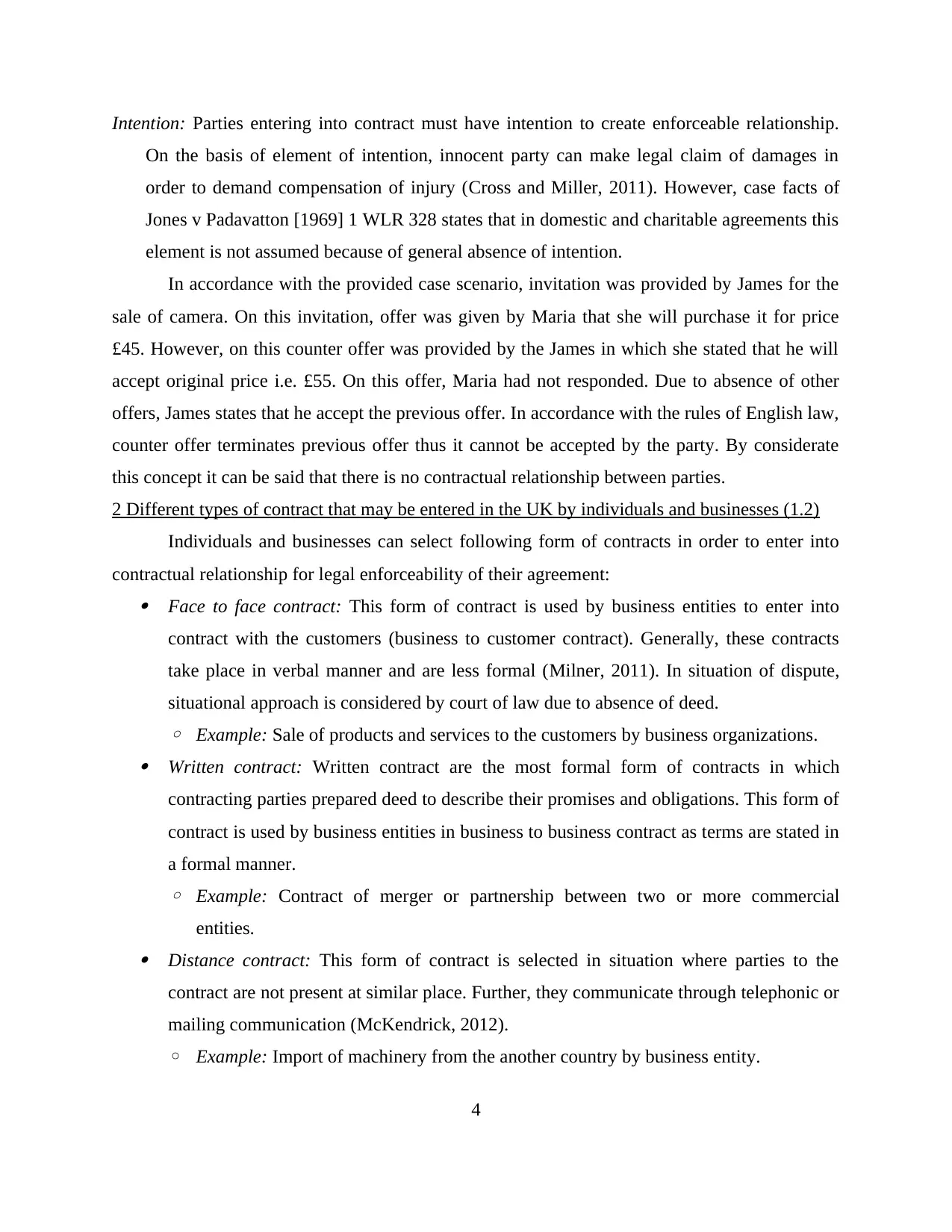
Intention: Parties entering into contract must have intention to create enforceable relationship.
On the basis of element of intention, innocent party can make legal claim of damages in
order to demand compensation of injury (Cross and Miller, 2011). However, case facts of
Jones v Padavatton [1969] 1 WLR 328 states that in domestic and charitable agreements this
element is not assumed because of general absence of intention.
In accordance with the provided case scenario, invitation was provided by James for the
sale of camera. On this invitation, offer was given by Maria that she will purchase it for price
£45. However, on this counter offer was provided by the James in which she stated that he will
accept original price i.e. £55. On this offer, Maria had not responded. Due to absence of other
offers, James states that he accept the previous offer. In accordance with the rules of English law,
counter offer terminates previous offer thus it cannot be accepted by the party. By considerate
this concept it can be said that there is no contractual relationship between parties.
2 Different types of contract that may be entered in the UK by individuals and businesses (1.2)
Individuals and businesses can select following form of contracts in order to enter into
contractual relationship for legal enforceability of their agreement: Face to face contract: This form of contract is used by business entities to enter into
contract with the customers (business to customer contract). Generally, these contracts
take place in verbal manner and are less formal (Milner, 2011). In situation of dispute,
situational approach is considered by court of law due to absence of deed.
◦ Example: Sale of products and services to the customers by business organizations. Written contract: Written contract are the most formal form of contracts in which
contracting parties prepared deed to describe their promises and obligations. This form of
contract is used by business entities in business to business contract as terms are stated in
a formal manner.
◦ Example: Contract of merger or partnership between two or more commercial
entities. Distance contract: This form of contract is selected in situation where parties to the
contract are not present at similar place. Further, they communicate through telephonic or
mailing communication (McKendrick, 2012).
◦ Example: Import of machinery from the another country by business entity.
4
On the basis of element of intention, innocent party can make legal claim of damages in
order to demand compensation of injury (Cross and Miller, 2011). However, case facts of
Jones v Padavatton [1969] 1 WLR 328 states that in domestic and charitable agreements this
element is not assumed because of general absence of intention.
In accordance with the provided case scenario, invitation was provided by James for the
sale of camera. On this invitation, offer was given by Maria that she will purchase it for price
£45. However, on this counter offer was provided by the James in which she stated that he will
accept original price i.e. £55. On this offer, Maria had not responded. Due to absence of other
offers, James states that he accept the previous offer. In accordance with the rules of English law,
counter offer terminates previous offer thus it cannot be accepted by the party. By considerate
this concept it can be said that there is no contractual relationship between parties.
2 Different types of contract that may be entered in the UK by individuals and businesses (1.2)
Individuals and businesses can select following form of contracts in order to enter into
contractual relationship for legal enforceability of their agreement: Face to face contract: This form of contract is used by business entities to enter into
contract with the customers (business to customer contract). Generally, these contracts
take place in verbal manner and are less formal (Milner, 2011). In situation of dispute,
situational approach is considered by court of law due to absence of deed.
◦ Example: Sale of products and services to the customers by business organizations. Written contract: Written contract are the most formal form of contracts in which
contracting parties prepared deed to describe their promises and obligations. This form of
contract is used by business entities in business to business contract as terms are stated in
a formal manner.
◦ Example: Contract of merger or partnership between two or more commercial
entities. Distance contract: This form of contract is selected in situation where parties to the
contract are not present at similar place. Further, they communicate through telephonic or
mailing communication (McKendrick, 2012).
◦ Example: Import of machinery from the another country by business entity.
4
Paraphrase This Document
Need a fresh take? Get an instant paraphrase of this document with our AI Paraphraser
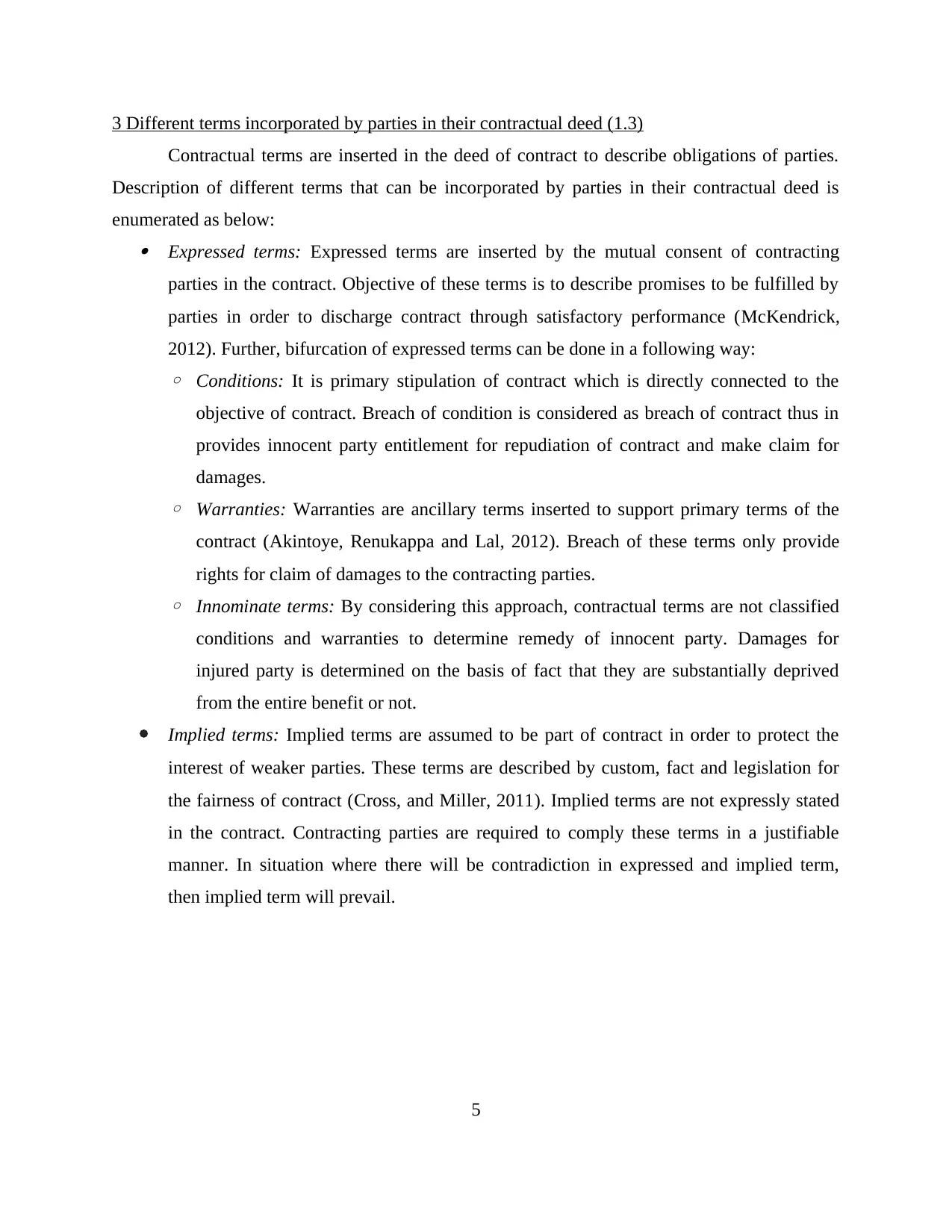
3 Different terms incorporated by parties in their contractual deed (1.3)
Contractual terms are inserted in the deed of contract to describe obligations of parties.
Description of different terms that can be incorporated by parties in their contractual deed is
enumerated as below: Expressed terms: Expressed terms are inserted by the mutual consent of contracting
parties in the contract. Objective of these terms is to describe promises to be fulfilled by
parties in order to discharge contract through satisfactory performance (McKendrick,
2012). Further, bifurcation of expressed terms can be done in a following way:
◦ Conditions: It is primary stipulation of contract which is directly connected to the
objective of contract. Breach of condition is considered as breach of contract thus in
provides innocent party entitlement for repudiation of contract and make claim for
damages.
◦ Warranties: Warranties are ancillary terms inserted to support primary terms of the
contract (Akintoye, Renukappa and Lal, 2012). Breach of these terms only provide
rights for claim of damages to the contracting parties.
◦ Innominate terms: By considering this approach, contractual terms are not classified
conditions and warranties to determine remedy of innocent party. Damages for
injured party is determined on the basis of fact that they are substantially deprived
from the entire benefit or not.
Implied terms: Implied terms are assumed to be part of contract in order to protect the
interest of weaker parties. These terms are described by custom, fact and legislation for
the fairness of contract (Cross, and Miller, 2011). Implied terms are not expressly stated
in the contract. Contracting parties are required to comply these terms in a justifiable
manner. In situation where there will be contradiction in expressed and implied term,
then implied term will prevail.
5
Contractual terms are inserted in the deed of contract to describe obligations of parties.
Description of different terms that can be incorporated by parties in their contractual deed is
enumerated as below: Expressed terms: Expressed terms are inserted by the mutual consent of contracting
parties in the contract. Objective of these terms is to describe promises to be fulfilled by
parties in order to discharge contract through satisfactory performance (McKendrick,
2012). Further, bifurcation of expressed terms can be done in a following way:
◦ Conditions: It is primary stipulation of contract which is directly connected to the
objective of contract. Breach of condition is considered as breach of contract thus in
provides innocent party entitlement for repudiation of contract and make claim for
damages.
◦ Warranties: Warranties are ancillary terms inserted to support primary terms of the
contract (Akintoye, Renukappa and Lal, 2012). Breach of these terms only provide
rights for claim of damages to the contracting parties.
◦ Innominate terms: By considering this approach, contractual terms are not classified
conditions and warranties to determine remedy of innocent party. Damages for
injured party is determined on the basis of fact that they are substantially deprived
from the entire benefit or not.
Implied terms: Implied terms are assumed to be part of contract in order to protect the
interest of weaker parties. These terms are described by custom, fact and legislation for
the fairness of contract (Cross, and Miller, 2011). Implied terms are not expressly stated
in the contract. Contracting parties are required to comply these terms in a justifiable
manner. In situation where there will be contradiction in expressed and implied term,
then implied term will prevail.
5
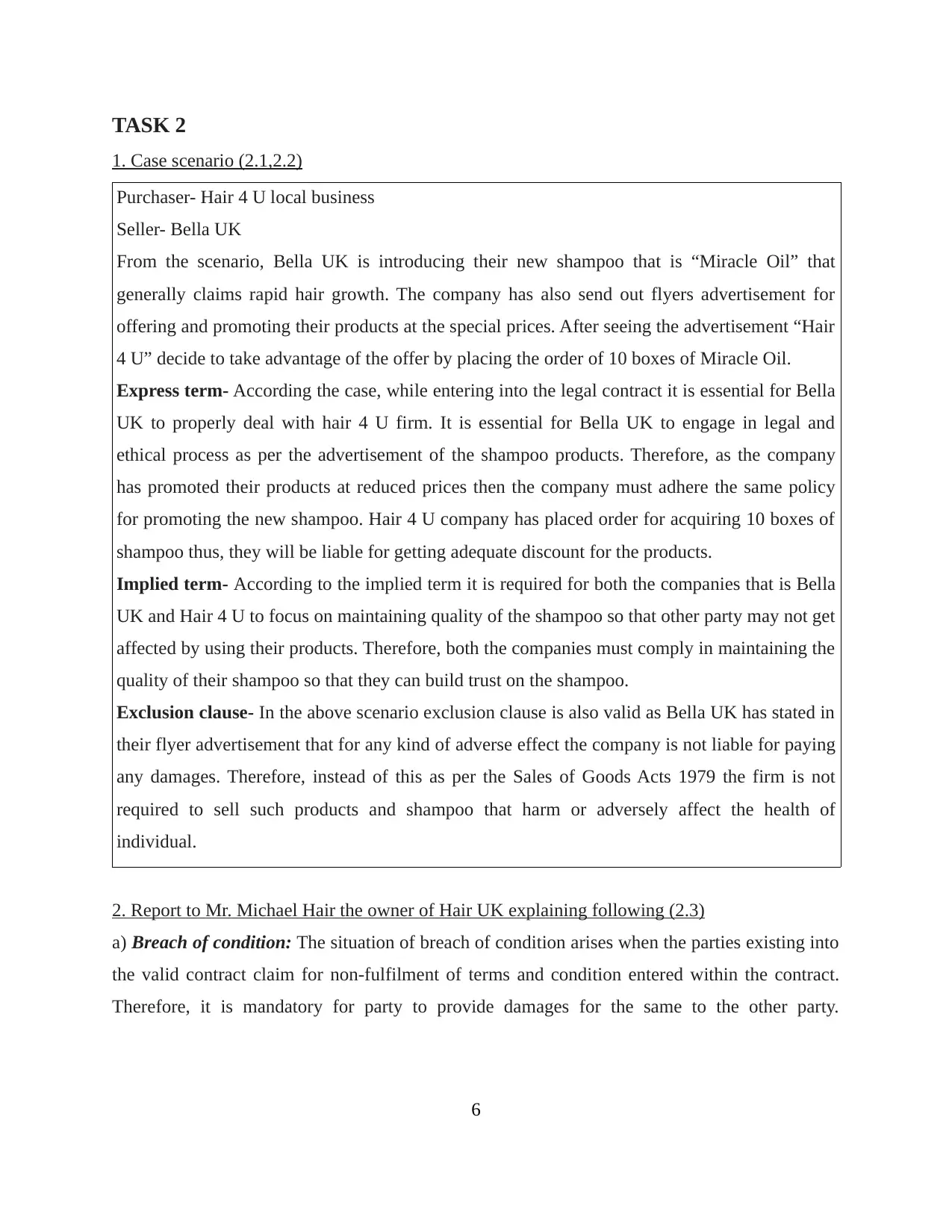
TASK 2
1. Case scenario (2.1,2.2)
Purchaser- Hair 4 U local business
Seller- Bella UK
From the scenario, Bella UK is introducing their new shampoo that is “Miracle Oil” that
generally claims rapid hair growth. The company has also send out flyers advertisement for
offering and promoting their products at the special prices. After seeing the advertisement “Hair
4 U” decide to take advantage of the offer by placing the order of 10 boxes of Miracle Oil.
Express term- According the case, while entering into the legal contract it is essential for Bella
UK to properly deal with hair 4 U firm. It is essential for Bella UK to engage in legal and
ethical process as per the advertisement of the shampoo products. Therefore, as the company
has promoted their products at reduced prices then the company must adhere the same policy
for promoting the new shampoo. Hair 4 U company has placed order for acquiring 10 boxes of
shampoo thus, they will be liable for getting adequate discount for the products.
Implied term- According to the implied term it is required for both the companies that is Bella
UK and Hair 4 U to focus on maintaining quality of the shampoo so that other party may not get
affected by using their products. Therefore, both the companies must comply in maintaining the
quality of their shampoo so that they can build trust on the shampoo.
Exclusion clause- In the above scenario exclusion clause is also valid as Bella UK has stated in
their flyer advertisement that for any kind of adverse effect the company is not liable for paying
any damages. Therefore, instead of this as per the Sales of Goods Acts 1979 the firm is not
required to sell such products and shampoo that harm or adversely affect the health of
individual.
2. Report to Mr. Michael Hair the owner of Hair UK explaining following (2.3)
a) Breach of condition: The situation of breach of condition arises when the parties existing into
the valid contract claim for non-fulfilment of terms and condition entered within the contract.
Therefore, it is mandatory for party to provide damages for the same to the other party.
6
1. Case scenario (2.1,2.2)
Purchaser- Hair 4 U local business
Seller- Bella UK
From the scenario, Bella UK is introducing their new shampoo that is “Miracle Oil” that
generally claims rapid hair growth. The company has also send out flyers advertisement for
offering and promoting their products at the special prices. After seeing the advertisement “Hair
4 U” decide to take advantage of the offer by placing the order of 10 boxes of Miracle Oil.
Express term- According the case, while entering into the legal contract it is essential for Bella
UK to properly deal with hair 4 U firm. It is essential for Bella UK to engage in legal and
ethical process as per the advertisement of the shampoo products. Therefore, as the company
has promoted their products at reduced prices then the company must adhere the same policy
for promoting the new shampoo. Hair 4 U company has placed order for acquiring 10 boxes of
shampoo thus, they will be liable for getting adequate discount for the products.
Implied term- According to the implied term it is required for both the companies that is Bella
UK and Hair 4 U to focus on maintaining quality of the shampoo so that other party may not get
affected by using their products. Therefore, both the companies must comply in maintaining the
quality of their shampoo so that they can build trust on the shampoo.
Exclusion clause- In the above scenario exclusion clause is also valid as Bella UK has stated in
their flyer advertisement that for any kind of adverse effect the company is not liable for paying
any damages. Therefore, instead of this as per the Sales of Goods Acts 1979 the firm is not
required to sell such products and shampoo that harm or adversely affect the health of
individual.
2. Report to Mr. Michael Hair the owner of Hair UK explaining following (2.3)
a) Breach of condition: The situation of breach of condition arises when the parties existing into
the valid contract claim for non-fulfilment of terms and condition entered within the contract.
Therefore, it is mandatory for party to provide damages for the same to the other party.
6
⊘ This is a preview!⊘
Do you want full access?
Subscribe today to unlock all pages.

Trusted by 1+ million students worldwide
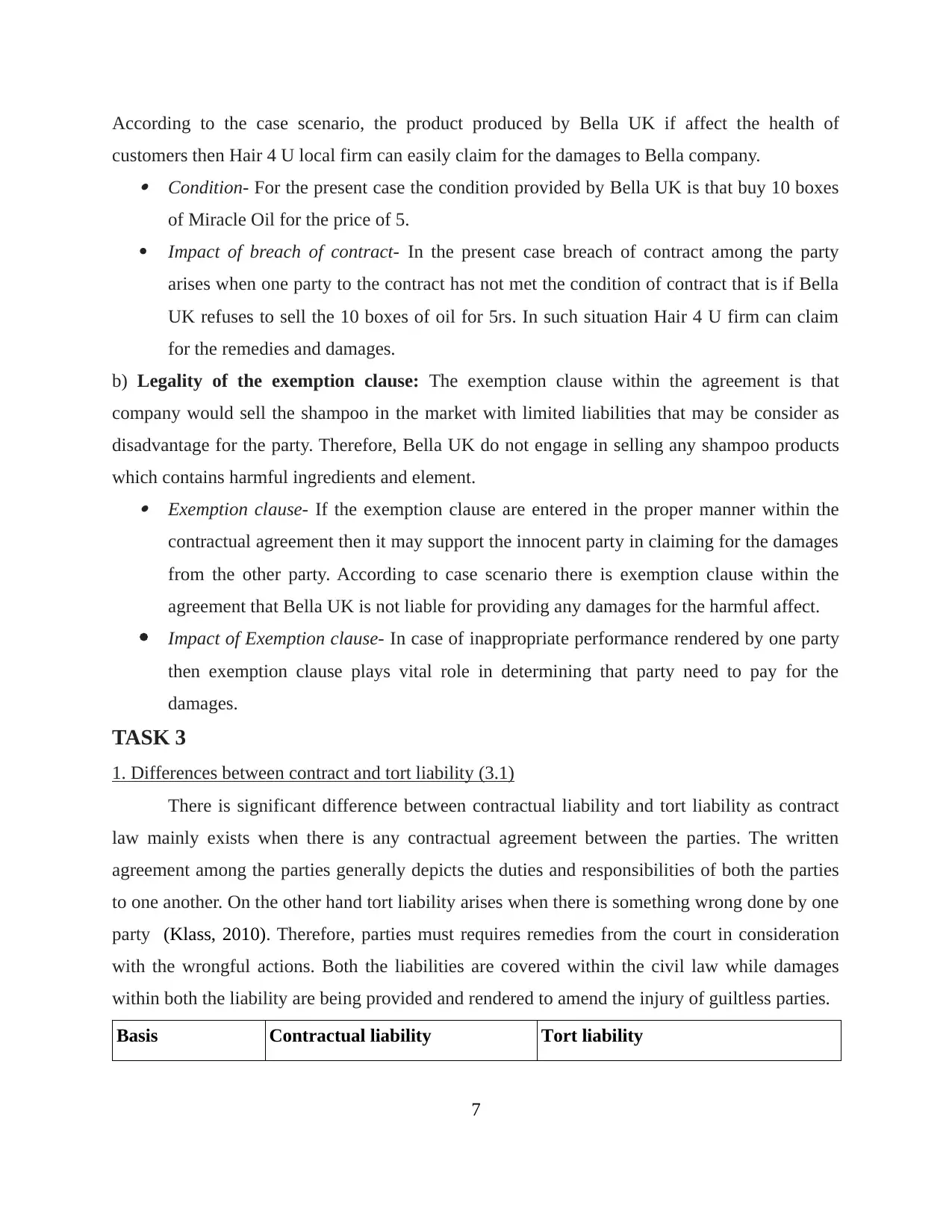
According to the case scenario, the product produced by Bella UK if affect the health of
customers then Hair 4 U local firm can easily claim for the damages to Bella company. Condition- For the present case the condition provided by Bella UK is that buy 10 boxes
of Miracle Oil for the price of 5.
Impact of breach of contract- In the present case breach of contract among the party
arises when one party to the contract has not met the condition of contract that is if Bella
UK refuses to sell the 10 boxes of oil for 5rs. In such situation Hair 4 U firm can claim
for the remedies and damages.
b) Legality of the exemption clause: The exemption clause within the agreement is that
company would sell the shampoo in the market with limited liabilities that may be consider as
disadvantage for the party. Therefore, Bella UK do not engage in selling any shampoo products
which contains harmful ingredients and element. Exemption clause- If the exemption clause are entered in the proper manner within the
contractual agreement then it may support the innocent party in claiming for the damages
from the other party. According to case scenario there is exemption clause within the
agreement that Bella UK is not liable for providing any damages for the harmful affect.
Impact of Exemption clause- In case of inappropriate performance rendered by one party
then exemption clause plays vital role in determining that party need to pay for the
damages.
TASK 3
1. Differences between contract and tort liability (3.1)
There is significant difference between contractual liability and tort liability as contract
law mainly exists when there is any contractual agreement between the parties. The written
agreement among the parties generally depicts the duties and responsibilities of both the parties
to one another. On the other hand tort liability arises when there is something wrong done by one
party (Klass, 2010). Therefore, parties must requires remedies from the court in consideration
with the wrongful actions. Both the liabilities are covered within the civil law while damages
within both the liability are being provided and rendered to amend the injury of guiltless parties.
Basis Contractual liability Tort liability
7
customers then Hair 4 U local firm can easily claim for the damages to Bella company. Condition- For the present case the condition provided by Bella UK is that buy 10 boxes
of Miracle Oil for the price of 5.
Impact of breach of contract- In the present case breach of contract among the party
arises when one party to the contract has not met the condition of contract that is if Bella
UK refuses to sell the 10 boxes of oil for 5rs. In such situation Hair 4 U firm can claim
for the remedies and damages.
b) Legality of the exemption clause: The exemption clause within the agreement is that
company would sell the shampoo in the market with limited liabilities that may be consider as
disadvantage for the party. Therefore, Bella UK do not engage in selling any shampoo products
which contains harmful ingredients and element. Exemption clause- If the exemption clause are entered in the proper manner within the
contractual agreement then it may support the innocent party in claiming for the damages
from the other party. According to case scenario there is exemption clause within the
agreement that Bella UK is not liable for providing any damages for the harmful affect.
Impact of Exemption clause- In case of inappropriate performance rendered by one party
then exemption clause plays vital role in determining that party need to pay for the
damages.
TASK 3
1. Differences between contract and tort liability (3.1)
There is significant difference between contractual liability and tort liability as contract
law mainly exists when there is any contractual agreement between the parties. The written
agreement among the parties generally depicts the duties and responsibilities of both the parties
to one another. On the other hand tort liability arises when there is something wrong done by one
party (Klass, 2010). Therefore, parties must requires remedies from the court in consideration
with the wrongful actions. Both the liabilities are covered within the civil law while damages
within both the liability are being provided and rendered to amend the injury of guiltless parties.
Basis Contractual liability Tort liability
7
Paraphrase This Document
Need a fresh take? Get an instant paraphrase of this document with our AI Paraphraser
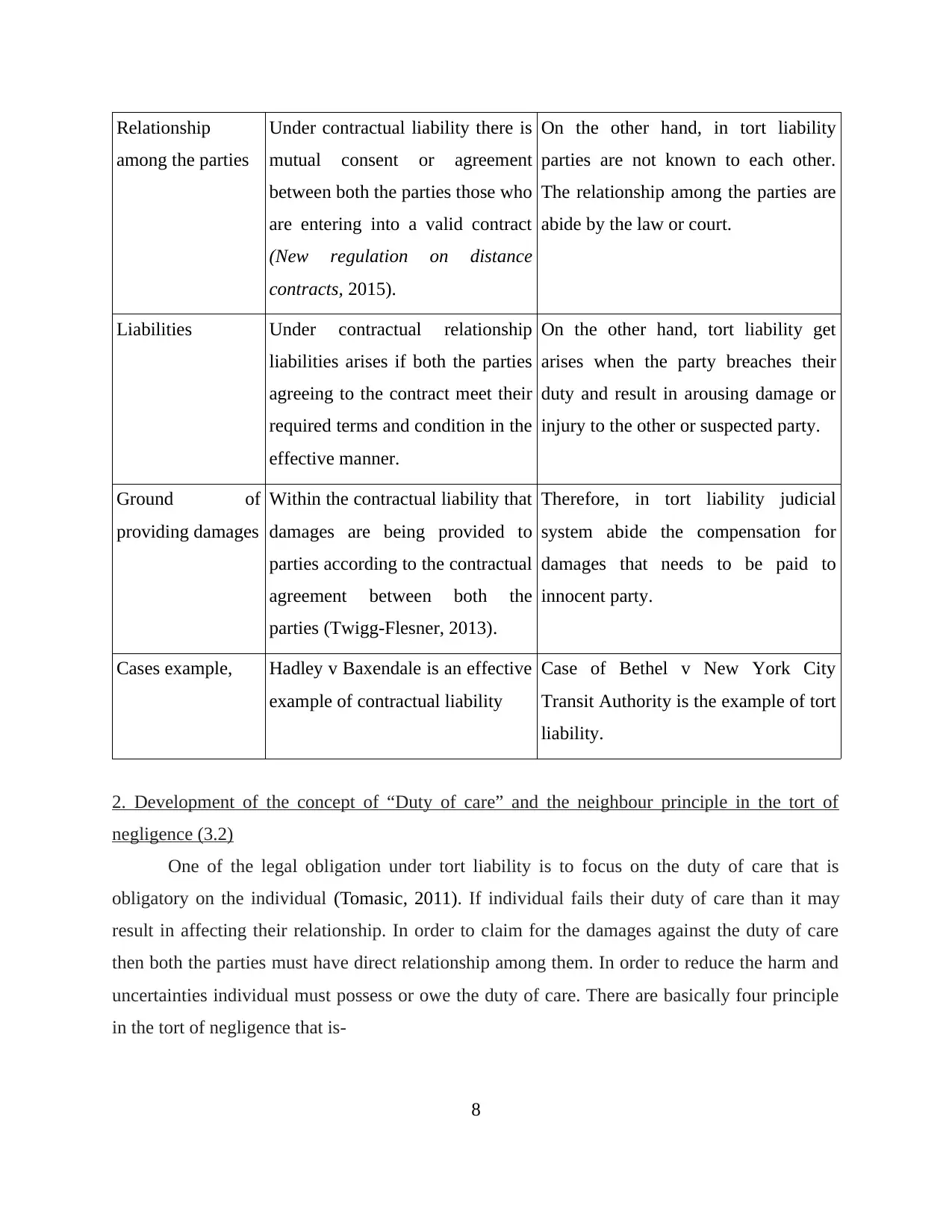
Relationship
among the parties
Under contractual liability there is
mutual consent or agreement
between both the parties those who
are entering into a valid contract
(New regulation on distance
contracts, 2015).
On the other hand, in tort liability
parties are not known to each other.
The relationship among the parties are
abide by the law or court.
Liabilities Under contractual relationship
liabilities arises if both the parties
agreeing to the contract meet their
required terms and condition in the
effective manner.
On the other hand, tort liability get
arises when the party breaches their
duty and result in arousing damage or
injury to the other or suspected party.
Ground of
providing damages
Within the contractual liability that
damages are being provided to
parties according to the contractual
agreement between both the
parties (Twigg-Flesner, 2013).
Therefore, in tort liability judicial
system abide the compensation for
damages that needs to be paid to
innocent party.
Cases example, Hadley v Baxendale is an effective
example of contractual liability
Case of Bethel v New York City
Transit Authority is the example of tort
liability.
2. Development of the concept of “Duty of care” and the neighbour principle in the tort of
negligence (3.2)
One of the legal obligation under tort liability is to focus on the duty of care that is
obligatory on the individual (Tomasic, 2011). If individual fails their duty of care than it may
result in affecting their relationship. In order to claim for the damages against the duty of care
then both the parties must have direct relationship among them. In order to reduce the harm and
uncertainties individual must possess or owe the duty of care. There are basically four principle
in the tort of negligence that is-
8
among the parties
Under contractual liability there is
mutual consent or agreement
between both the parties those who
are entering into a valid contract
(New regulation on distance
contracts, 2015).
On the other hand, in tort liability
parties are not known to each other.
The relationship among the parties are
abide by the law or court.
Liabilities Under contractual relationship
liabilities arises if both the parties
agreeing to the contract meet their
required terms and condition in the
effective manner.
On the other hand, tort liability get
arises when the party breaches their
duty and result in arousing damage or
injury to the other or suspected party.
Ground of
providing damages
Within the contractual liability that
damages are being provided to
parties according to the contractual
agreement between both the
parties (Twigg-Flesner, 2013).
Therefore, in tort liability judicial
system abide the compensation for
damages that needs to be paid to
innocent party.
Cases example, Hadley v Baxendale is an effective
example of contractual liability
Case of Bethel v New York City
Transit Authority is the example of tort
liability.
2. Development of the concept of “Duty of care” and the neighbour principle in the tort of
negligence (3.2)
One of the legal obligation under tort liability is to focus on the duty of care that is
obligatory on the individual (Tomasic, 2011). If individual fails their duty of care than it may
result in affecting their relationship. In order to claim for the damages against the duty of care
then both the parties must have direct relationship among them. In order to reduce the harm and
uncertainties individual must possess or owe the duty of care. There are basically four principle
in the tort of negligence that is-
8
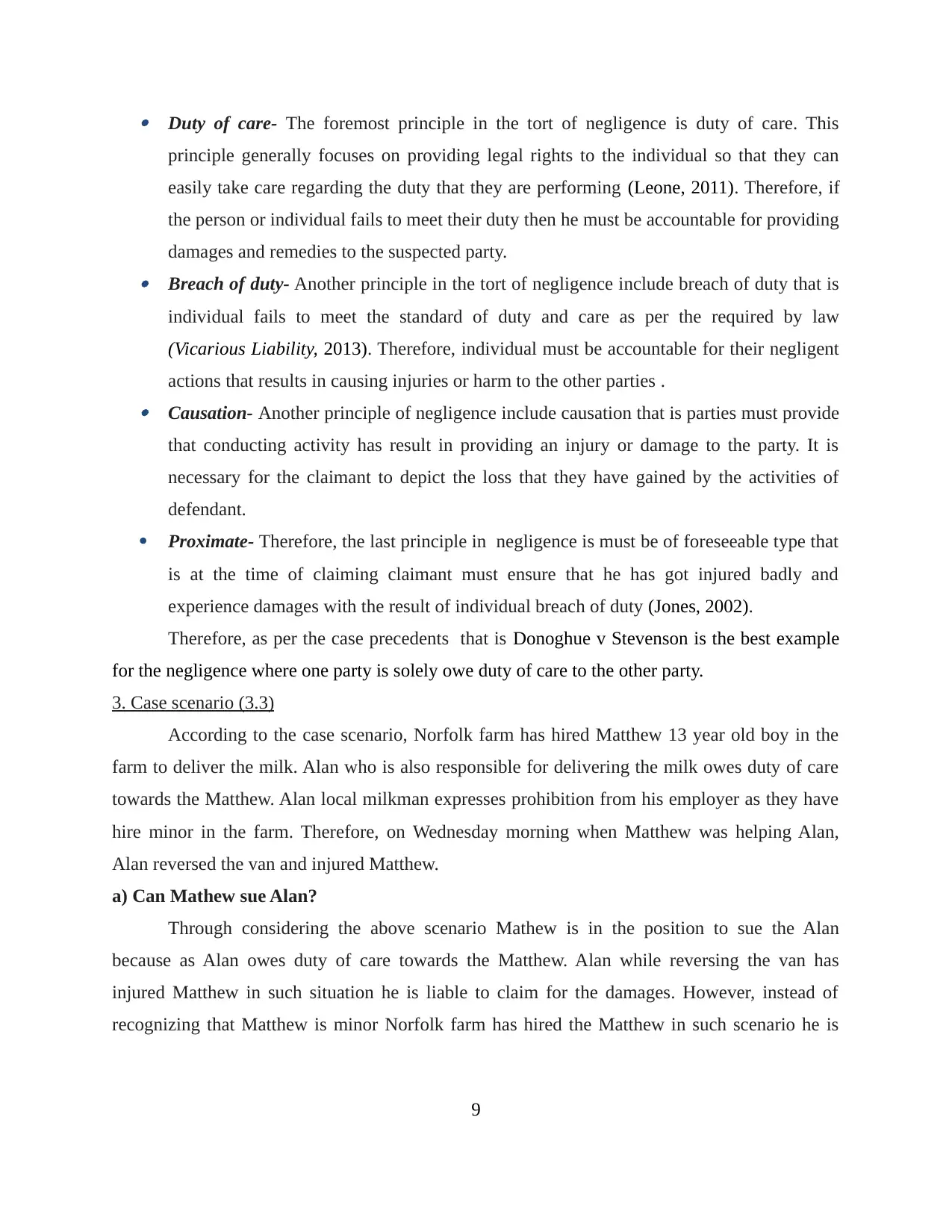
Duty of care- The foremost principle in the tort of negligence is duty of care. This
principle generally focuses on providing legal rights to the individual so that they can
easily take care regarding the duty that they are performing (Leone, 2011). Therefore, if
the person or individual fails to meet their duty then he must be accountable for providing
damages and remedies to the suspected party. Breach of duty- Another principle in the tort of negligence include breach of duty that is
individual fails to meet the standard of duty and care as per the required by law
(Vicarious Liability, 2013). Therefore, individual must be accountable for their negligent
actions that results in causing injuries or harm to the other parties . Causation- Another principle of negligence include causation that is parties must provide
that conducting activity has result in providing an injury or damage to the party. It is
necessary for the claimant to depict the loss that they have gained by the activities of
defendant.
Proximate- Therefore, the last principle in negligence is must be of foreseeable type that
is at the time of claiming claimant must ensure that he has got injured badly and
experience damages with the result of individual breach of duty (Jones, 2002).
Therefore, as per the case precedents that is Donoghue v Stevenson is the best example
for the negligence where one party is solely owe duty of care to the other party.
3. Case scenario (3.3)
According to the case scenario, Norfolk farm has hired Matthew 13 year old boy in the
farm to deliver the milk. Alan who is also responsible for delivering the milk owes duty of care
towards the Matthew. Alan local milkman expresses prohibition from his employer as they have
hire minor in the farm. Therefore, on Wednesday morning when Matthew was helping Alan,
Alan reversed the van and injured Matthew.
a) Can Mathew sue Alan?
Through considering the above scenario Mathew is in the position to sue the Alan
because as Alan owes duty of care towards the Matthew. Alan while reversing the van has
injured Matthew in such situation he is liable to claim for the damages. However, instead of
recognizing that Matthew is minor Norfolk farm has hired the Matthew in such scenario he is
9
principle generally focuses on providing legal rights to the individual so that they can
easily take care regarding the duty that they are performing (Leone, 2011). Therefore, if
the person or individual fails to meet their duty then he must be accountable for providing
damages and remedies to the suspected party. Breach of duty- Another principle in the tort of negligence include breach of duty that is
individual fails to meet the standard of duty and care as per the required by law
(Vicarious Liability, 2013). Therefore, individual must be accountable for their negligent
actions that results in causing injuries or harm to the other parties . Causation- Another principle of negligence include causation that is parties must provide
that conducting activity has result in providing an injury or damage to the party. It is
necessary for the claimant to depict the loss that they have gained by the activities of
defendant.
Proximate- Therefore, the last principle in negligence is must be of foreseeable type that
is at the time of claiming claimant must ensure that he has got injured badly and
experience damages with the result of individual breach of duty (Jones, 2002).
Therefore, as per the case precedents that is Donoghue v Stevenson is the best example
for the negligence where one party is solely owe duty of care to the other party.
3. Case scenario (3.3)
According to the case scenario, Norfolk farm has hired Matthew 13 year old boy in the
farm to deliver the milk. Alan who is also responsible for delivering the milk owes duty of care
towards the Matthew. Alan local milkman expresses prohibition from his employer as they have
hire minor in the farm. Therefore, on Wednesday morning when Matthew was helping Alan,
Alan reversed the van and injured Matthew.
a) Can Mathew sue Alan?
Through considering the above scenario Mathew is in the position to sue the Alan
because as Alan owes duty of care towards the Matthew. Alan while reversing the van has
injured Matthew in such situation he is liable to claim for the damages. However, instead of
recognizing that Matthew is minor Norfolk farm has hired the Matthew in such scenario he is
9
⊘ This is a preview!⊘
Do you want full access?
Subscribe today to unlock all pages.

Trusted by 1+ million students worldwide
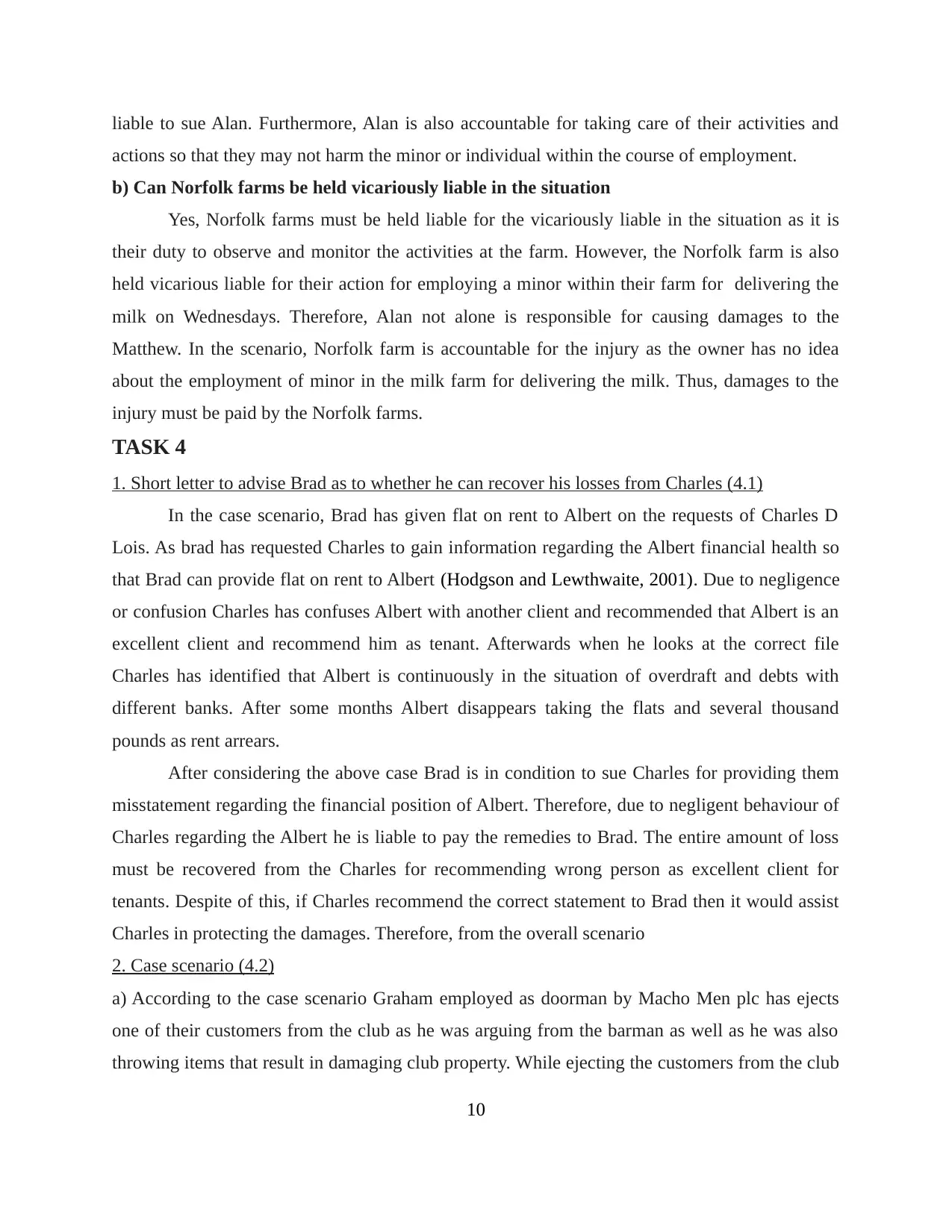
liable to sue Alan. Furthermore, Alan is also accountable for taking care of their activities and
actions so that they may not harm the minor or individual within the course of employment.
b) Can Norfolk farms be held vicariously liable in the situation
Yes, Norfolk farms must be held liable for the vicariously liable in the situation as it is
their duty to observe and monitor the activities at the farm. However, the Norfolk farm is also
held vicarious liable for their action for employing a minor within their farm for delivering the
milk on Wednesdays. Therefore, Alan not alone is responsible for causing damages to the
Matthew. In the scenario, Norfolk farm is accountable for the injury as the owner has no idea
about the employment of minor in the milk farm for delivering the milk. Thus, damages to the
injury must be paid by the Norfolk farms.
TASK 4
1. Short letter to advise Brad as to whether he can recover his losses from Charles (4.1)
In the case scenario, Brad has given flat on rent to Albert on the requests of Charles D
Lois. As brad has requested Charles to gain information regarding the Albert financial health so
that Brad can provide flat on rent to Albert (Hodgson and Lewthwaite, 2001). Due to negligence
or confusion Charles has confuses Albert with another client and recommended that Albert is an
excellent client and recommend him as tenant. Afterwards when he looks at the correct file
Charles has identified that Albert is continuously in the situation of overdraft and debts with
different banks. After some months Albert disappears taking the flats and several thousand
pounds as rent arrears.
After considering the above case Brad is in condition to sue Charles for providing them
misstatement regarding the financial position of Albert. Therefore, due to negligent behaviour of
Charles regarding the Albert he is liable to pay the remedies to Brad. The entire amount of loss
must be recovered from the Charles for recommending wrong person as excellent client for
tenants. Despite of this, if Charles recommend the correct statement to Brad then it would assist
Charles in protecting the damages. Therefore, from the overall scenario
2. Case scenario (4.2)
a) According to the case scenario Graham employed as doorman by Macho Men plc has ejects
one of their customers from the club as he was arguing from the barman as well as he was also
throwing items that result in damaging club property. While ejecting the customers from the club
10
actions so that they may not harm the minor or individual within the course of employment.
b) Can Norfolk farms be held vicariously liable in the situation
Yes, Norfolk farms must be held liable for the vicariously liable in the situation as it is
their duty to observe and monitor the activities at the farm. However, the Norfolk farm is also
held vicarious liable for their action for employing a minor within their farm for delivering the
milk on Wednesdays. Therefore, Alan not alone is responsible for causing damages to the
Matthew. In the scenario, Norfolk farm is accountable for the injury as the owner has no idea
about the employment of minor in the milk farm for delivering the milk. Thus, damages to the
injury must be paid by the Norfolk farms.
TASK 4
1. Short letter to advise Brad as to whether he can recover his losses from Charles (4.1)
In the case scenario, Brad has given flat on rent to Albert on the requests of Charles D
Lois. As brad has requested Charles to gain information regarding the Albert financial health so
that Brad can provide flat on rent to Albert (Hodgson and Lewthwaite, 2001). Due to negligence
or confusion Charles has confuses Albert with another client and recommended that Albert is an
excellent client and recommend him as tenant. Afterwards when he looks at the correct file
Charles has identified that Albert is continuously in the situation of overdraft and debts with
different banks. After some months Albert disappears taking the flats and several thousand
pounds as rent arrears.
After considering the above case Brad is in condition to sue Charles for providing them
misstatement regarding the financial position of Albert. Therefore, due to negligent behaviour of
Charles regarding the Albert he is liable to pay the remedies to Brad. The entire amount of loss
must be recovered from the Charles for recommending wrong person as excellent client for
tenants. Despite of this, if Charles recommend the correct statement to Brad then it would assist
Charles in protecting the damages. Therefore, from the overall scenario
2. Case scenario (4.2)
a) According to the case scenario Graham employed as doorman by Macho Men plc has ejects
one of their customers from the club as he was arguing from the barman as well as he was also
throwing items that result in damaging club property. While ejecting the customers from the club
10
Paraphrase This Document
Need a fresh take? Get an instant paraphrase of this document with our AI Paraphraser
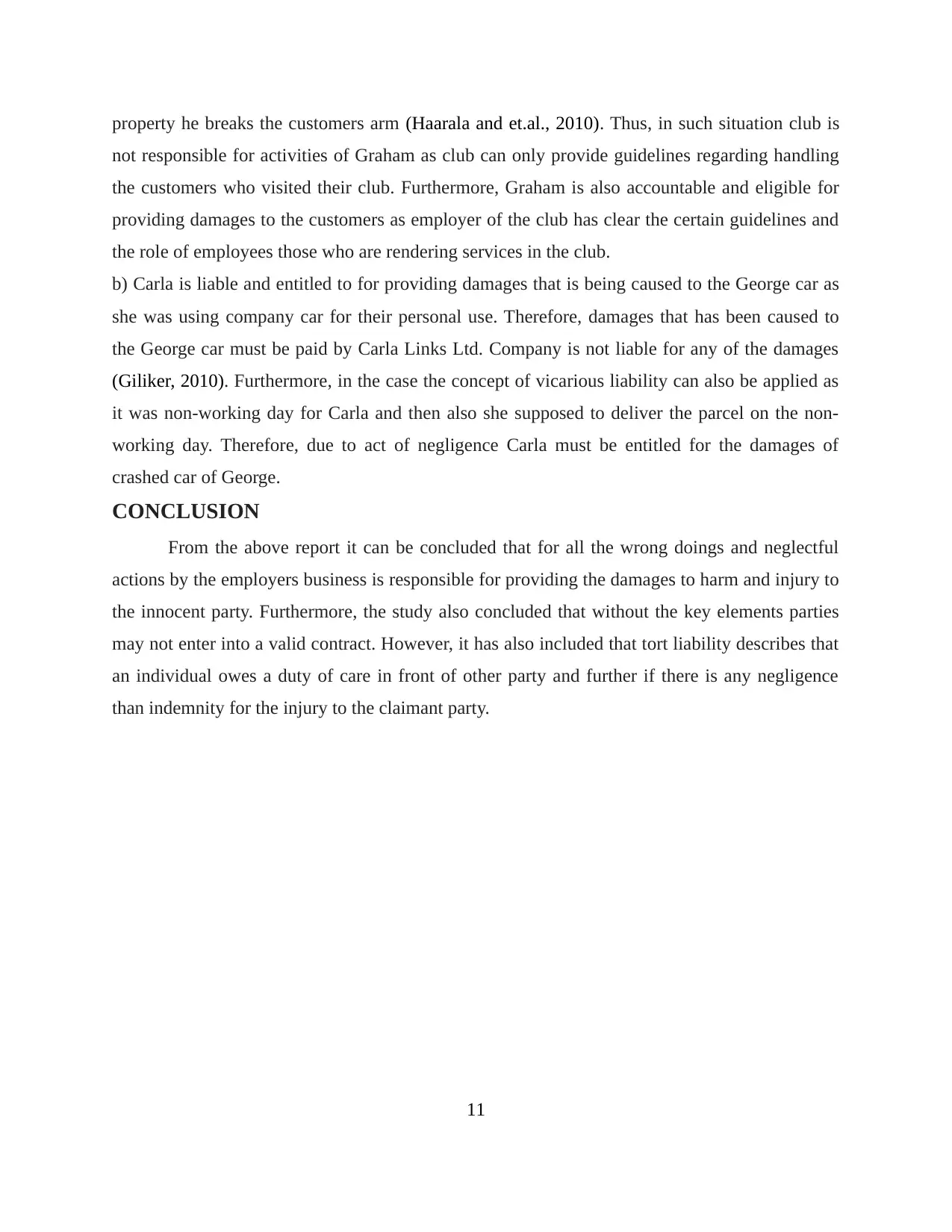
property he breaks the customers arm (Haarala and et.al., 2010). Thus, in such situation club is
not responsible for activities of Graham as club can only provide guidelines regarding handling
the customers who visited their club. Furthermore, Graham is also accountable and eligible for
providing damages to the customers as employer of the club has clear the certain guidelines and
the role of employees those who are rendering services in the club.
b) Carla is liable and entitled to for providing damages that is being caused to the George car as
she was using company car for their personal use. Therefore, damages that has been caused to
the George car must be paid by Carla Links Ltd. Company is not liable for any of the damages
(Giliker, 2010). Furthermore, in the case the concept of vicarious liability can also be applied as
it was non-working day for Carla and then also she supposed to deliver the parcel on the non-
working day. Therefore, due to act of negligence Carla must be entitled for the damages of
crashed car of George.
CONCLUSION
From the above report it can be concluded that for all the wrong doings and neglectful
actions by the employers business is responsible for providing the damages to harm and injury to
the innocent party. Furthermore, the study also concluded that without the key elements parties
may not enter into a valid contract. However, it has also included that tort liability describes that
an individual owes a duty of care in front of other party and further if there is any negligence
than indemnity for the injury to the claimant party.
11
not responsible for activities of Graham as club can only provide guidelines regarding handling
the customers who visited their club. Furthermore, Graham is also accountable and eligible for
providing damages to the customers as employer of the club has clear the certain guidelines and
the role of employees those who are rendering services in the club.
b) Carla is liable and entitled to for providing damages that is being caused to the George car as
she was using company car for their personal use. Therefore, damages that has been caused to
the George car must be paid by Carla Links Ltd. Company is not liable for any of the damages
(Giliker, 2010). Furthermore, in the case the concept of vicarious liability can also be applied as
it was non-working day for Carla and then also she supposed to deliver the parcel on the non-
working day. Therefore, due to act of negligence Carla must be entitled for the damages of
crashed car of George.
CONCLUSION
From the above report it can be concluded that for all the wrong doings and neglectful
actions by the employers business is responsible for providing the damages to harm and injury to
the innocent party. Furthermore, the study also concluded that without the key elements parties
may not enter into a valid contract. However, it has also included that tort liability describes that
an individual owes a duty of care in front of other party and further if there is any negligence
than indemnity for the injury to the claimant party.
11
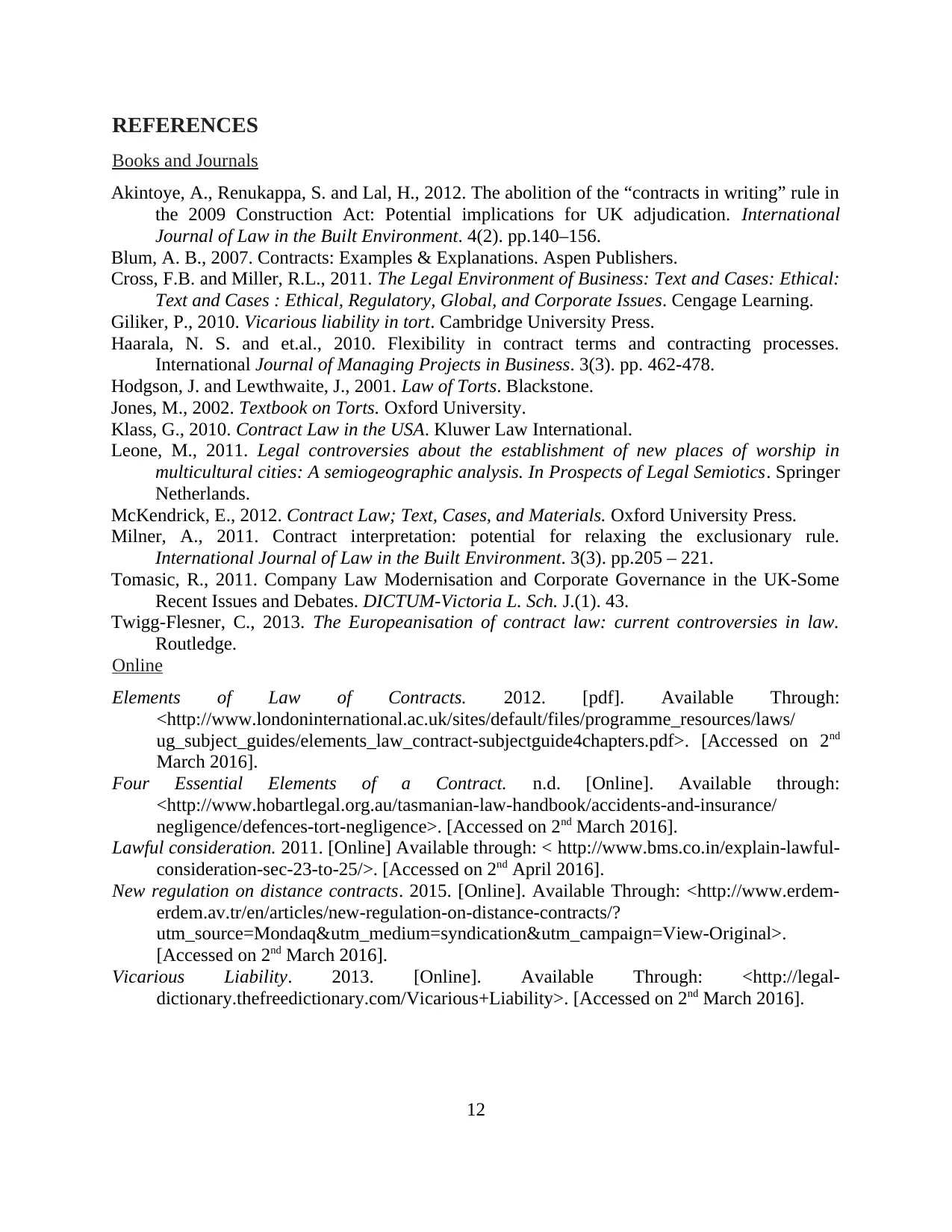
REFERENCES
Books and Journals
Akintoye, A., Renukappa, S. and Lal, H., 2012. The abolition of the “contracts in writing” rule in
the 2009 Construction Act: Potential implications for UK adjudication. International
Journal of Law in the Built Environment. 4(2). pp.140–156.
Blum, A. B., 2007. Contracts: Examples & Explanations. Aspen Publishers.
Cross, F.B. and Miller, R.L., 2011. The Legal Environment of Business: Text and Cases: Ethical:
Text and Cases : Ethical, Regulatory, Global, and Corporate Issues. Cengage Learning.
Giliker, P., 2010. Vicarious liability in tort. Cambridge University Press.
Haarala, N. S. and et.al., 2010. Flexibility in contract terms and contracting processes.
International Journal of Managing Projects in Business. 3(3). pp. 462-478.
Hodgson, J. and Lewthwaite, J., 2001. Law of Torts. Blackstone.
Jones, M., 2002. Textbook on Torts. Oxford University.
Klass, G., 2010. Contract Law in the USA. Kluwer Law International.
Leone, M., 2011. Legal controversies about the establishment of new places of worship in
multicultural cities: A semiogeographic analysis. In Prospects of Legal Semiotics. Springer
Netherlands.
McKendrick, E., 2012. Contract Law; Text, Cases, and Materials. Oxford University Press.
Milner, A., 2011. Contract interpretation: potential for relaxing the exclusionary rule.
International Journal of Law in the Built Environment. 3(3). pp.205 – 221.
Tomasic, R., 2011. Company Law Modernisation and Corporate Governance in the UK-Some
Recent Issues and Debates. DICTUM-Victoria L. Sch. J.(1). 43.
Twigg-Flesner, C., 2013. The Europeanisation of contract law: current controversies in law.
Routledge.
Online
Elements of Law of Contracts. 2012. [pdf]. Available Through:
<http://www.londoninternational.ac.uk/sites/default/files/programme_resources/laws/
ug_subject_guides/elements_law_contract-subjectguide4chapters.pdf>. [Accessed on 2nd
March 2016].
Four Essential Elements of a Contract. n.d. [Online]. Available through:
<http://www.hobartlegal.org.au/tasmanian-law-handbook/accidents-and-insurance/
negligence/defences-tort-negligence>. [Accessed on 2nd March 2016].
Lawful consideration. 2011. [Online] Available through: < http://www.bms.co.in/explain-lawful-
consideration-sec-23-to-25/>. [Accessed on 2nd April 2016].
New regulation on distance contracts. 2015. [Online]. Available Through: <http://www.erdem-
erdem.av.tr/en/articles/new-regulation-on-distance-contracts/?
utm_source=Mondaq&utm_medium=syndication&utm_campaign=View-Original>.
[Accessed on 2nd March 2016].
Vicarious Liability. 2013. [Online]. Available Through: <http://legal-
dictionary.thefreedictionary.com/Vicarious+Liability>. [Accessed on 2nd March 2016].
12
Books and Journals
Akintoye, A., Renukappa, S. and Lal, H., 2012. The abolition of the “contracts in writing” rule in
the 2009 Construction Act: Potential implications for UK adjudication. International
Journal of Law in the Built Environment. 4(2). pp.140–156.
Blum, A. B., 2007. Contracts: Examples & Explanations. Aspen Publishers.
Cross, F.B. and Miller, R.L., 2011. The Legal Environment of Business: Text and Cases: Ethical:
Text and Cases : Ethical, Regulatory, Global, and Corporate Issues. Cengage Learning.
Giliker, P., 2010. Vicarious liability in tort. Cambridge University Press.
Haarala, N. S. and et.al., 2010. Flexibility in contract terms and contracting processes.
International Journal of Managing Projects in Business. 3(3). pp. 462-478.
Hodgson, J. and Lewthwaite, J., 2001. Law of Torts. Blackstone.
Jones, M., 2002. Textbook on Torts. Oxford University.
Klass, G., 2010. Contract Law in the USA. Kluwer Law International.
Leone, M., 2011. Legal controversies about the establishment of new places of worship in
multicultural cities: A semiogeographic analysis. In Prospects of Legal Semiotics. Springer
Netherlands.
McKendrick, E., 2012. Contract Law; Text, Cases, and Materials. Oxford University Press.
Milner, A., 2011. Contract interpretation: potential for relaxing the exclusionary rule.
International Journal of Law in the Built Environment. 3(3). pp.205 – 221.
Tomasic, R., 2011. Company Law Modernisation and Corporate Governance in the UK-Some
Recent Issues and Debates. DICTUM-Victoria L. Sch. J.(1). 43.
Twigg-Flesner, C., 2013. The Europeanisation of contract law: current controversies in law.
Routledge.
Online
Elements of Law of Contracts. 2012. [pdf]. Available Through:
<http://www.londoninternational.ac.uk/sites/default/files/programme_resources/laws/
ug_subject_guides/elements_law_contract-subjectguide4chapters.pdf>. [Accessed on 2nd
March 2016].
Four Essential Elements of a Contract. n.d. [Online]. Available through:
<http://www.hobartlegal.org.au/tasmanian-law-handbook/accidents-and-insurance/
negligence/defences-tort-negligence>. [Accessed on 2nd March 2016].
Lawful consideration. 2011. [Online] Available through: < http://www.bms.co.in/explain-lawful-
consideration-sec-23-to-25/>. [Accessed on 2nd April 2016].
New regulation on distance contracts. 2015. [Online]. Available Through: <http://www.erdem-
erdem.av.tr/en/articles/new-regulation-on-distance-contracts/?
utm_source=Mondaq&utm_medium=syndication&utm_campaign=View-Original>.
[Accessed on 2nd March 2016].
Vicarious Liability. 2013. [Online]. Available Through: <http://legal-
dictionary.thefreedictionary.com/Vicarious+Liability>. [Accessed on 2nd March 2016].
12
⊘ This is a preview!⊘
Do you want full access?
Subscribe today to unlock all pages.

Trusted by 1+ million students worldwide
1 out of 12
Related Documents
Your All-in-One AI-Powered Toolkit for Academic Success.
+13062052269
info@desklib.com
Available 24*7 on WhatsApp / Email
![[object Object]](/_next/static/media/star-bottom.7253800d.svg)
Unlock your academic potential
Copyright © 2020–2025 A2Z Services. All Rights Reserved. Developed and managed by ZUCOL.





